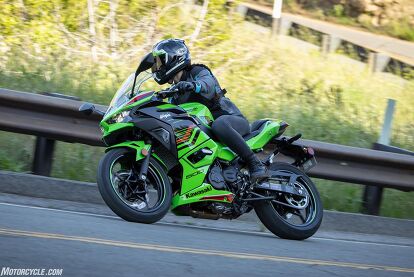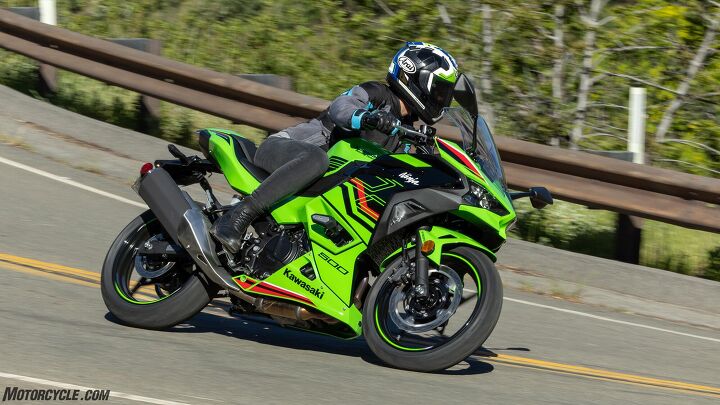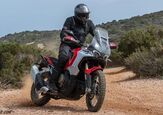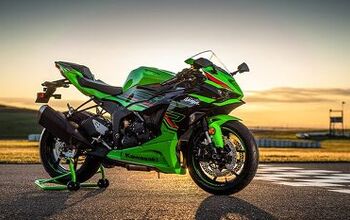2024 Kawasaki Ninja 500 Review – First Ride

Kawasaki has been dominating the realm of entry-level motorcycles, especially with the introduction of the Ninja 400 in 2018. In fact, they were so capable and enjoyable to ride that I bought one myself and it has become one of my favorite motorcycles in my stable. The Ninja 400 wasn't perfect, and I had my gripes about it. So, of course, I was very intrigued by the unveiling of the new Ninja 500. As luck would have it, I was fortunate enough to find myself invited to a press launch for the new Kawasaki in Malibu, California, to see what this new machine is all about. The Malibu area hosts some of the best canyon roads in the United States – a perfect proving ground for testing the new, larger displacement Ninja 500.
2024 Kawasaki Ninja 500
The Ninja 500 simply builds on an already successful platform from the 400. More than just a bigger engine, there are small styling and electronic upgrades, too. Best of all, the base price matches the outgoing 400.
Editor Score: 86.5%
Engine | 18/20 | Suspension | 12/15 | Transmission | 9/10 |
Brakes | 9/10 | Instruments | 4.5/5 | Ergonomics | 8/10 |
Appearance | 8/10 | Desirability | 9/10 | Value | 9/10 |
Highs
- Stylish
- The TFT display elevates the experience
- Competitive pricing
Sighs
- As it was with the 400, the exhaust shield cramps your right foot
- The little Ninja gained weight
- Calling it a 500 is a bit deceiving
The first and most noticeable difference with the Ninja 500 is its appearance. Like its larger siblings, the Ninja 500 has a more sporty and edgy look. I personally find it much more attractive than the previous Ninja 400. The front end of the Ninja 500 looks more aggressive and stylish. Kawasaki opted for a more classic color scheme and even presented a 40th-anniversary edition boasting the classic lime green/pearl crystal white/blue livery. There are six different model variations for the new Ninja: the base Ninja 500, Ninja 500 KRT Edition, Ninja 500 ABS, Ninja 500 SE ABS, Ninja 500 KRT Edition SE ABS, and the Ninja 500 SE 40th Anniversary Edition ABS. The MSRP of these models range from $5,299 to $6,599. Considering the 2023 Ninja 400 also starts at $5,299, I was a bit surprised since the 500 is advertised as an upgraded and better version of the Ninja 400.
So, what are the differences between the model variations, and are they worth it? First, I appreciate that Kawasaki is still offering a base model without ABS. I understand and respect that ABS is a great feature, especially for entry-level riders, or in bad weather, but I find it to be intrusive sometimes, especially at the track.
The non-SE models received an upgrade to the instrument cluster, now using a full LCD panel instead of the previous Ninja 400 analog hybrid cluster. The new panel is still simple but has a much more modern look. It features a digital bar-style tachometer, fuel gauge, average and current fuel consumption, connected device notifications, an Economical Riding Indicator, speedometer, coolant temperature, a clock, and a service indicator. The SE variations come equipped with a TFT display offering crisp visibility. This dash also provides a shift lamp, average speed, battery voltage, and an oil change reminder. Both the TFT and LCD instruments have the capability for smartphone connectivity with the RIDEOLOGY app. Connecting a smartphone allows for notifications and also syncs with GPS to track rides. There’s even a maintenance log, which is pretty neat! The model I rode had the TFT dash, but honestly, it didn't impress me much. I liked the visibility of the screen, but I always prefer an analog tachometer over digital. Other additions exclusive to the SE models are LED turn signals, a 2.5-inch taller windscreen, a radiator screen, frame sliders, a seat cowl, a tank pad and knee pads, and a USB charger.
Now, let's get into the mechanical components of the 2024 Ninja 500. The engine is heavily based on the Ninja 400’s power plant, using most of the same internal components. However, there are some major differences. The engine has a 451cc displacement and uses a newly designed crankshaft, connecting rods, and piston. I'll admit, I was confused by the "500" in the name for an engine that’s only 451cc. Sure, many motorcycles don't reflect their exact displacement, but this seems borderline egregious. The higher displacement was achieved by lengthening the stroke to 58.6 mm but keeping the same bore at 70 mm. What does this mean for the consumer? Usually, keeping the same bore but lengthening the stroke improves fuel efficiency but at the cost of peak power. It can also cause peak torque to be achieved at a lower rpm.
Kawasaki claims the upgraded internals allow the new engine to reach 51 horsepower at 10,000 rpm and 31.7 lb-ft of torque at 7,500 rpm (at the crank). The last dyno run of a Ninja 400 at Motorcycle.com, produced 44 hp at 10,000 rpm and 24.6 lb-ft at 8,300 rpm (at the wheel). An assist and slipper clutch is also included and has been slightly revised to handle the new increased engine capacity. During my ride on the 2024 Ninja 500 KRT Edition SE ABS, the clutch pull was noticeably smoother and easier than on the Ninja 400.
The chassis, suspension, brakes, and wheels are virtually the same as the Ninja 400. The fork is non-adjustable with 4.7 inches of travel, and the shock is only adjustable for preload with 5.1 inches of travel. The front brake uses a single 310mm semi-floating disc with 2-piston calipers, and the rear brake uses a single 220mm disc with a single-piston caliper. When stopped, it was easy for me to put my feet on the ground and while riding my knees were bent but not uncomfortably. The front brake lever provides consistent pressure, and if you need to stop quickly, the two-piston caliper does surprisingly well. The seat height is manageable, even for riders with a 30-inch inseam like myself, and it is very comfortable. The claimed curb weight for the model I rode, the 2024 Ninja 500 KRT Edition SE ABS, is 381.5 lbs. That is 15.5 pounds heavier than the 2023 Ninja 400 KRT Edition with ABS.
Comparing my Ninja 400 base model to the Ninja 500 KRT Edition SE, the 500 does edge out the Ninja 400 slightly in terms of engine performance. Even with the higher curb weight, I didn't feel too much of it when accelerating, cornering, and stopping. That said, I was hoping for a more noticeable power increase and less, or even the same curb weight. I noticed the front ABS seemed to activate with much less brake pressure than I was expecting. Likewise, the rear ABS also stepped in well before I would have wanted it, becoming too intrusive for my liking during our ride through the canyons.
My biggest complaint is the location of the exhaust. Just like the Ninja 400, Kawasaki placed the exhaust too close to the right-side foot peg. With my women's size 8.5 shoes, I am constantly hitting my heel on it, which impedes my riding position. This might sound petty, but it reduces comfort and confidence when I am constantly adjusting my foot position during spirited rides.
I attempted to use the RIDEOLOGY app before our ride began but it would not connect to my smartphone because there were 13 other journalists trying to do the same thing.
Moving on, here's what I enjoyed about the 2024 Ninja 500. The looks and styling are far more appealing and intense. I appreciate that it resembles the bigger Ninja ZX-6R and Ninja ZX-10R, giving it a more aggressive appearance. Even though I personally prefer an analog tachometer, I found the new TFT dash to be more fitting to the new style of the Ninja 500. If one is able to get the RIDEOLOGY app functioning, I'm a big fan of tracking maintenance and think this capability encourages riders to engage more with their motorcycle. I love the added hazard button! I can't stress enough how important I believe it is to have a safety function like this, especially for entry-level riders. And lastly, the price of these new machines is attractive. It's fair enough for entry-level or expert riders, and it honestly surprised me. I expected an outrageous difference from the Ninja 400, but in fact, they start at the same price!
Overall, the new 2024 Ninja 500 is an excellent motorcycle. It's edgy enough to grab attention, nimble enough to handle the canyons, comfortable for spirited riding or commuting, and cost-effective. I believe that most riders with a Ninja 400 would upgrade to a ZX-6R or ZX-10R over buying a Ninja 500, but that being said, this bike is a great choice for new riders that want a motorcycle they can learn on and love riding.
In Gear

- Helmet: Arai Corsair-X Rea-6
- Jacket: Bilt Calypso 2
- Gloves: Dainese Carbon 4
- Boots: Sedici Tourisma WP
2024 Kawasaki Ninja 500 Specifications | |
|---|---|
Engine | 4-stroke, liquid-cooled, DOHC, 4-valve cylinder-head, Parallel-Twin |
Displacement | 451 cc |
Bore & Stroke | 70.0 x 58.6 mm |
Horsepower | 51.0 hp at 10,000 rpm (claimed) |
Torque | 31.7 lb-ft. at 7,500 rpm (claimed) |
Compression Ratio | 11.3:1 |
Fuel System | DFI w/ dual 32 mm throttle Bodies |
Ignition TCBI with Digital Advance | TCBI with digital advance |
Clutch | Assist and slipper clutch |
Transmission | 6-speed |
Final Drive | Sealed chain |
Frame | Trellis, high-tensile steel |
Front Suspension | 41mm hydraulic telescopic fork; 4.7 inches of travel |
Rear Suspension | Horizontal back-link shock with adjustable spring preload; 5.1 inches of travel |
Front Brake | Single 310mm semi-floating disc with 2-piston caliper. ABS optional. |
Rear Brake | Single 220mm disc with single-piston caliper. ABS optional. |
Front Tire Size | 110/70-17 |
Rear Tire Size | 150/60-17 |
Rake/Trail | 24.7° / 3.6 inches |
Length | 78.5 inches |
Width | 28.7 inches |
Height | 44.1 inches 46.5 inches (SE models) |
Ground Clearance | 5.7 inches |
Wheelbase | 54.1 inches |
Fuel Tank Capacity | 3.7 gallons |
Seat Height | 30.9 inches |
Curb Weight | 374.9 lb (ABS) 377.1 lb (ABS, 50-State models) 370.4 lb (non-ABS) 372.6 lb (non-ABS, 50-State models) 379.3 lb (SE models) 381.5 lb (SE, 50-State models) all weights claimed |
Warranty | 12 months |
Kawasaki Protection Plus | 12, 24, 36 or 48 months |
We are committed to finding, researching, and recommending the best products. We earn commissions from purchases you make using the retail links in our product reviews. Learn more about how this works.
Become a Motorcycle.com insider. Get the latest motorcycle news first by subscribing to our newsletter here.

My motorcycle addiction began in 2013 after buying a 1986 Ninja 250 to save money on gas. We all know, it motorcycles never truly save anyone money :). Most of my riding experience has been sport bikes on the street and the track. I recently started riding dirt bikes on trails and a little bit on MX. I am a certified MSF instructor, control rider for multiple track day organizations, and a current expert supermoto racer. I like to save money when I can so I do most of the maintenance on my motorcycles. Valve adjustments, engine rebuilds, and tire changes just to name a few.
More by Sylvia Houston














































































Comments
Join the conversation
I have a 2023 Ninja 400, and it is just fantastic. I’ve considered upgrading to the 500, but mine has a full exhaust and tune, and now has equal power to the 500, but weighs about 21 lbs less! Really no need to upgrade, and a used 400 in great shape would now be a heck of a deal.
Wait a minute here,… the old Ninja 500 (EX500) made about 60 HP, and 34 ft lb of torque. Where is the technological advancement???